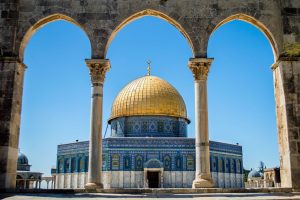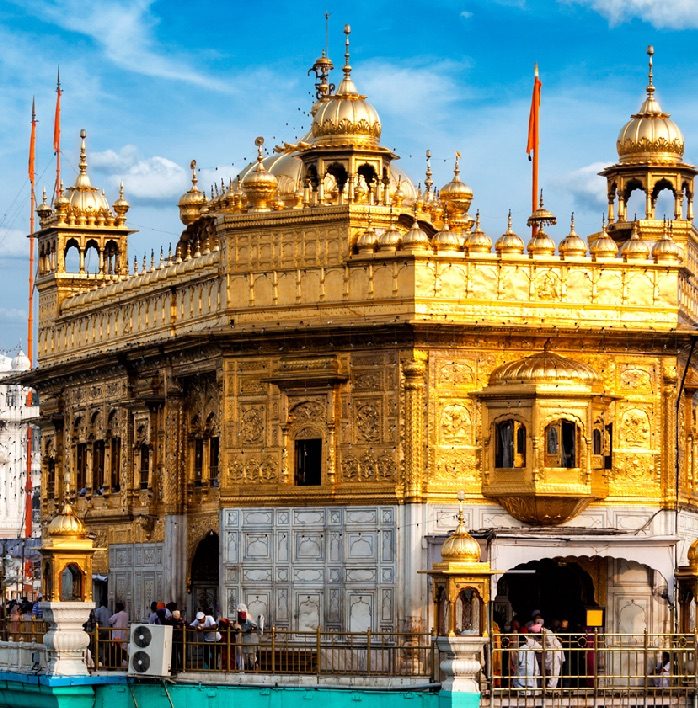
For over 3,000 years the Temple Mount on Mount Moriah in Jerusalem has held special significance for the three Abrahamic faiths of Judaism, Christianity and Islam, as many of the great prophets have served their communities here.
According to the Bible, David (as) first built an altar around this site around 1,000 BCE, and soon after, his son Solomon (as) built his temple here in 960 BCE with the wealth that was pouring into his kingdom. The construction took 7 years.[1] This was where the Ethiopian Queen Bilqis came and accepted the One God.[2] However, Solomon’s Temple was destroyed by the Persian King Nebuchadnezzar in 586 BCE after which the Jews were exiled from the region. The temple had hosted the legendary Ark of the Covenant which disappeared after this assault.
Cyrus the Great, a more benevolent Persian King, allowed the Jews to return to Palestine and they rebuilt their temple (known as the Second Temple). Having been through trauma, this was a period of prophets that warned their Jewish people to return to their faith or face further calamities.[3] Alexander the Great took Palestine in 332 BCE and then Greek culture dominated, including the establishment of Greek altars, forcing Jews to stop their worship and reading the Pentateuch, and preventing them from observing the Sabbath. With the Maccabean revolt, the temple was reclaimed by the Jews and rededicated for worship in 165 BCE.[4] The Greeks were thus replaced by the Romans.
The Second Temple was extended significantly by Herod the Great around 10 BCE, including the size of the Temple Mount complex itself.[5] As the Jews began to trade in the temple and were once again distracted away from spirituality, it was here that Jesus(as) began to preach to try to reform the Jews under Roman occupation.
The Temple of Herod had a main temple on the centre of the complex, where the Holy of Holies was kept and the main altar for sacrifices. Behind the altar would have been the sacred rock, which according to the Talmud was where Abraham (as), Noah (as), Cain (as), Abel (as) and Jacob (as) offered sacrifices to God.
At this time, there were four main influential groups among the Jews; the Sadducees, Pharisees, Essenes and Zealots. As the Zealots became more militant and challenged the Romans, the Romans crushed the Jews in 70 CE. It is estimated that 6,000 Jews died on the Temple Mount, as the temple was destroyed, and the Jews were expelled. In the centuries that followed, Jerusalem became home to many Christians. Much of the Western Wall remained.
Islam came to Jerusalem through Hazrat Umar (ra) around 638 CE. Jerusalem was significant for Muslims as initially this was the direction of their prayers until the qibla changed to Makkah in Arabia. The Temple Mount was also location of the Night Journey of Prophet Muhammad (sa). Muslims built the Dome of the Rock in 691 CE and then the Al-Aqsa Mosque in 715 CE. The Dome of the Rock was built around that same significant rock. The name of the Mount was now changed to Al-Haram al-Sharif.
The Muslims were welcomed as liberators and protected the rights of Jews and Christians in Jerusalem, but soon the peace would be shattered by Christian Crusades and since then, there has been continuous political and sectarian upheaval.
Modern Jerusalem is contested by all hold the Temple Mount in high significance. The Muslims worship in the Al-Aqsa Mosque and preserve the Dome of the Rock, while Jews worship at the Wailing Wall, one of the only remnants from the Jewish temple complexes.
ENDNOTES
[1] Hershel Shanks, Ancient Israel – A Short History from Abraham to the Roman Destruction of the Temple (Washington, USA: Biblical Archaeological Society, 1988), 100.
[2] The Holy Qur’an, 27:28-45.
[3] J. L. Sheler, The Rise of Three Faiths (USA: National Geographic Society, 2009), 32.
[4] LaMoine F. DeVries, Cities of the Biblical World (Massachusetts, USA: Hendrickson Publishers, 1997), 290.
[5] Ian Wilson, The Bible is History (London, UK: Weidenfeld & Nicolson, 1999), 123.




Add Comment